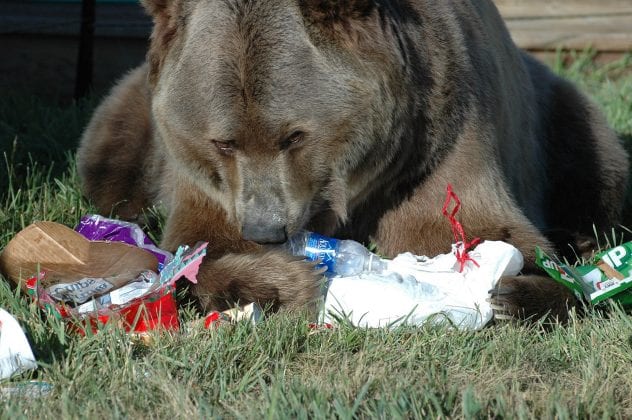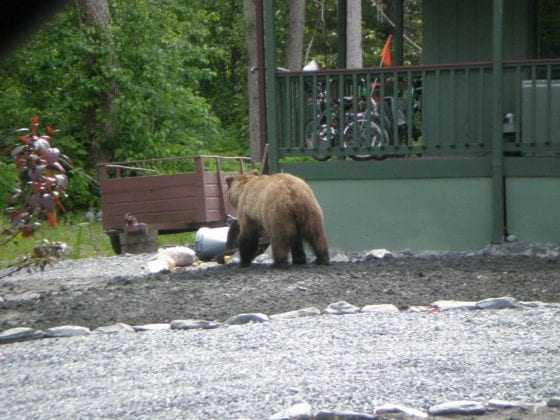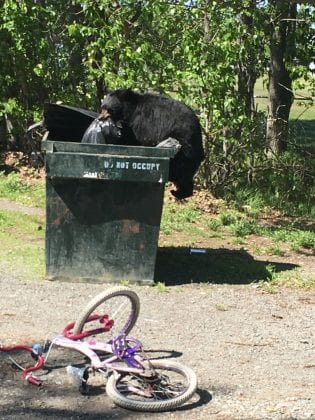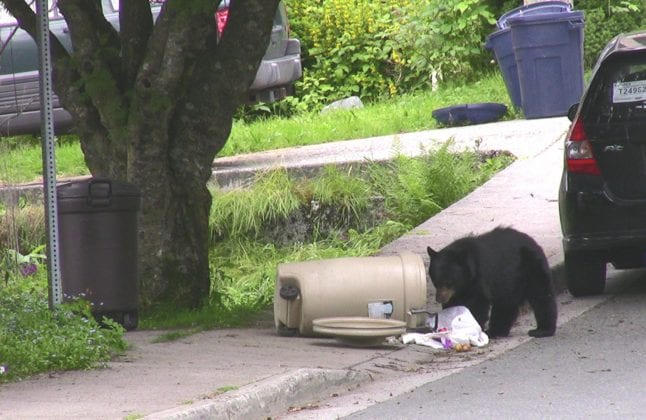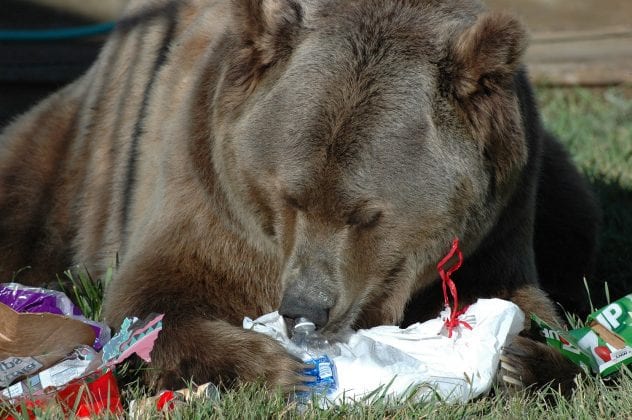If you’re like me, you’re watching those berry bushes closely and furiously gathering those sweet gems. We’re not the only ones watching those bushes, though. The bears are closely eying them too. As with previous years, the Cordova Police Department, the Alaska Wildlife Troopers, and the Alaska Department of Fish and Game are collaborating on how bear-related calls are handled. Our strategy is proactive – and it focuses on trash.
Berries and spawning salmon draw bears close to neighborhoods, but trash keeps them there. Leaving trash accessible to bears is like leaving cookies on your counter and trusting your dog to leave them alone while you’re gone. Most dogs can’t resist the temptation, just like bears can’t resist easy meals. Leaving out garbage and other attractants is bad for bears and people alike.
Generally, bears increasingly target garbage in town as fall sets in. This is because bears become focused on consuming as many calories as possible before going into their dens for the winter. As salmon runs and berries dwindle, bears take what they can, including garbage, birdseed, pet food and anything else available around our homes.
When bears find food around homes, they often hang around looking for more and can lose their fear of people. Such human-conditioned bears can be hazardous to people, pets and property, and usually end up being killed.
If you encounter a bear you believe presents a public safety threat, please call CPD or AWT. Keep in mind, though, that the mere presence of a bear does not constitute a public safety concern. If you see a bear that is not a public safety concern, but believe ADFG should know about it (perhaps it’s getting into trash or other improperly stored bear attractants), please give us a call.
Law enforcement responding to bear calls involving improperly stored trash or other attractants will issue citations for “intentionally or negligently” feeding bears. This can mean a $310 fine. Also, remember that in most cases, officers will no longer haze bears as that just prolongs the inevitable and may increase the hazard. Trapping and relocation is not an option as bears are amazingly good at finding their way back. By the time a bear becomes a public safety risk it has drawn a death sentence. How do we best avoid risks to public safety and needlessly killing bears? Prevention.
Following are some reminders on how to handle bear attractants to keep bears away from our homes:
- GARBAGE: Securely store all garbage inside a building or shed or in a bear-resistant container. Do not put trash out on the street until the morning of garbage pickup. Trash can be taken to the baler during business hours. Public use dumpsters are also available at times.
- FISH WASTE: Use designated fish cleaning stations or freeze fish waste and stinky garbage until garbage day.
- BIRDSEED: Bears love birdseed. Take down all birdfeeders April 15th through Oct. 31 and clean up spilled seed too.
- GRILLS: Clean grills throughout with a wire brush after cooking. Empty the grease trap or bring it inside after each use. If possible, store your grill inside a garage or shed when not in use.
- FISH SMOKERS: Smoking fish attracts bears. Do not leave your smoker unattended.
- PET FOOD: If you feed your pets outside, be sure to bring in any uneaten food inside when they are done. Failing to do so may result in a dog fight with a brown bear. Bears love dog food even more than dogs do!
- LIVESTOCK: Bears do occasionally kill and eat livestock, especially ducks, chickens and rabbits. Use an electric fence around livestock enclosures to keep bears out. Electric fences can also work for dog yards and smokers. Getting zapped by an electric fence won’t kill the bear, but it will be a shocking experience the bear won’t want to repeat!
- LIVESTOCK FOOD: Bears will eat anything you feed your livestock. Secure all feed inside a building or in a bear-resistant container.
If all measures above are taken, human-bear conflicts can be dramatically reduced. State law allows bears to be killed in defense of life or property, if you did not provoke an attack or cause a problem by negligently leaving human or pet food or garbage in a manner that attracts bears and if you have done everything else you can to protect your life and property. If possible, call AWT or CPD first. If officers are unable to respond and lethal means is the only alternative, shoot to kill; a wounded bear only aggravates an already dangerous situation. Also, remember that shooting in an urban setting is risky and illegal unless the situation is truly dire. Remember, if a bear has been attracted to your home or camp by improperly stored food or garbage, it cannot be legally killed. Illegally killing a bear could mean a citation for discharging a firearm within city limits or a citation for taking a bear without a harvest ticket, and a citation for feeding wildlife.
When a bear is killed in defense of life or property, call AWT or ADFG and report it immediately. All bears killed in defense of life or property must be skinned with claws and evidence of sex attached and the skull removed and then immediately turned over to ADFG.
If you see a bear getting into trash or other bear attractants, call ADFG at 907-424-3215. If you’re thinking the dump might be a good place for the “bear viewing,” keep in mind that you can be charged with Criminal Trespass in The Second Degree (AS11.46.320. If a person enters or remains unlawfully in or upon premises where notice against trespass is given by posting in a reasonably conspicuous manner under the circumstances, they can be charged with a Class B Misdemeanor which carries a penalty of up to 10 days in jail and a $2,000.00 fine.)
Also, if you have ideas about how we can keep this community clean and safe for people and bears, please call and share your ideas. The city refuse department and ADFG are currently exploring how Cordova can improve efforts on this important issue.
We’re all familiar with the adage “good fences make good neighbors.” Our community, however, doesn’t rely on fences to get along. We make decisions based on what is considerate to others. Making choices in this way will also influence our behavior in regards to keeping bears and our community safe. After all, bears came with the neighborhood.
For more information about bears, bear attractants and electric fences — go to www.alaskabears.alaska.gov.
Charlotte Westing is a Prince William Sound Area Wildlife Biologist for the Alaska Department of Fish and Game in Cordova.
